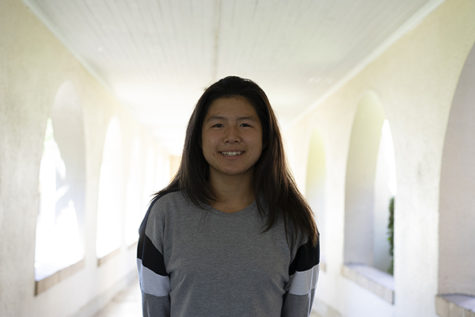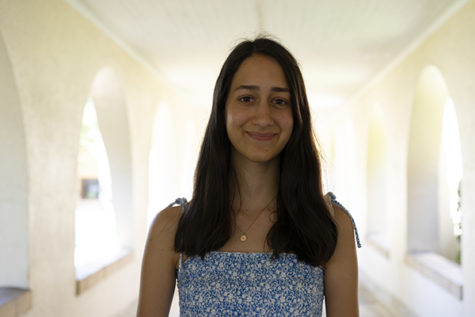Censor This, #%@*!
Blocking expression has become a prominent issue, preventing artists from communicating their beliefs and in turn halting society’s ability to grow from the exposure to controversial perspectives.
Controversial and sexual expressions of art are the most frequent targets of censorship crusades, fostering the fine line between offensive content and an artists power to convey their unfiltered messages. As many platforms within society continue to block artwork that is deemed offensive, this censorship illuminates the struggle between spreading free thought and creating a “safe” environment.
“Obscene” Content
In a historical sense, nudity and sexual content in art were rooted in divine and idealist themes; in more contemporary art forms, these concepts and their application have amassed heavy criticism, in part due to the shift in audiences’ perceptions. When promoted in the name of body positivity or sexual freedom, such art is created to send messages of activism rather than pornography. The censorship of artwork that portrays potentially inappropriate topics does more than shield audiences from ideas considered vulgar or obscene; it stifles the voices of communities that seek to open up the discussion to taboo topics.
Social media platforms including Instagram, Youtube and Tumblr have cracked down on posts considered sexually explicit or obscene, causing outrage in many communities who feel that they cannot exercise their freedom of expression. At the end of 2018, Tumblr enacted a regulation to permanently ban adult content and has been a source of alarm for many Tumblr users, as it eliminated a safe platform where they could openly express themselves. However, an opposing view to Tumblr’s previously-relaxed moderation is that it allowed for users to share troubling posts of child pornography and Nazi agitation, causing Apple to remove Tumblr from the app store, ultimately prompting this ban. Though promising to exclude art portraying nudity from the ban, Tumblr has continually incorrectly flagged such content, fracturing communities that seek to promote body positivity.
Instagram also has a strict policy regarding images of nudity, stating that “there are times when people might want to share nude images that are artistic or creative in nature, but for a variety of reasons, we don’t allow nudity on Instagram.” Since Instagram is a popular platform to spread artwork and promote messages of activism, this policy poses an obstacle for some artists who want to explore topics outside of their guidelines. Emma Toma, a Paly graduate and photographer, uses Instagram to promote her art. Her photos, depicting BDSM and nudity, are used to push a message of sexual freedom and enabling female but are often censored by Instagram. “My images aim to perceive women in an empowering way while exploring various themes of sex, love, dominance, submission, equality,” Toma stated in an Instagram post.
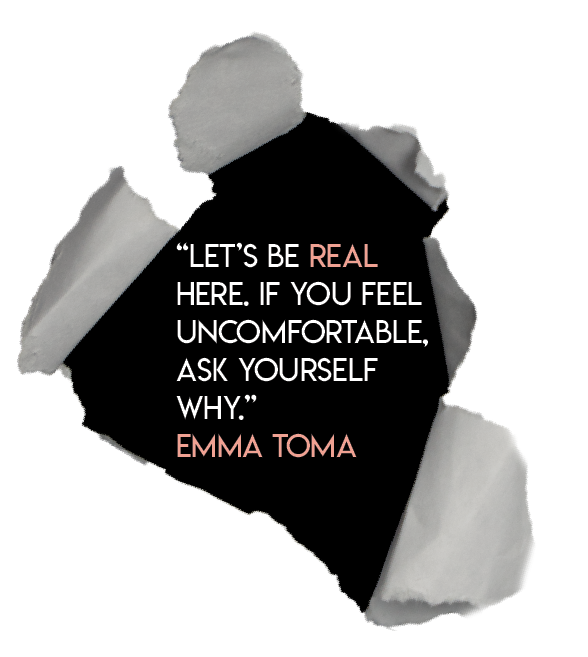
Because of this, her posts on Instagram are often removed. Though her photos contain content that may be interpreted as obscene or graphic, Toma’s meaning is very positive and functions as a form of activism. “My goal is to push your stereotypical ideals of how a woman should act and present herself,” Toma said. “There are no men in the photos because the woman is taking control of her own sexuality and exploring it for herself, aside from traditional sexual norms and confinements.”
The censorship of artists like Toma begs the question of whether creative expression can be hindered for the sake of promoting content that is appropriate for all audiences. In response, Toma said, “Let’s be real here. If you feel uncomfortable, ask yourself why. Think about why a girl taking control of her own pleasure, her own body makes you feel weird, possibly disgusted or turned off.”
Artist Affiliation
Scandalous artists are being silenced, not only by media but also by the public. Unlike artists who have their art blocked due to the controversy around their messages, many are boycotted as a repercussion of decisions made in their personal lives.
The question of if this silencing is censorship arises when the public itself is boycotting people who exhibit erratic or dangerous behavior. Problematic creators such as Chris Brown, R. Kelly, Melanie Martinez, Kathy Griffin and Roseanne Barr are examples of the downfall in one’s careers after people unearthed information regarding their partaking in immoral activities.
Singer Chris Brown was found guilty of assaulting his former girlfriend Rihanna in 2009, resulting in a backlash of hate from many members of society as well as a heavy depletion of his fanbase that threatened to terminate his career. His presence on the radio has diminished greatly, and many fans are immediately judged for supporting either him or his music.
Another example is Kathy Griffin, an actress and comedian, who posted an image of herself grasping the hair of a decapitated and bloody head that bore a striking resemblance to Donald Trump. She received significant criticism for the photos’ brutality and many argued that it promoted violence. The adverse reaction to this event caused Griffin to be removed from the CNN New Year show, which she had co-hosted for many years, and to receive impactful amounts of negative press. This scandal stands to be one of the most prevalent associations with Griffin in the current media and overshadows her previous accomplishments.
Melanie Martinez, a rising artist in the music industry, maintained a rapidly increasing fan base until news broke about her alleged sexual assault. Ever since the incident, her following has significantly decreased and she has received no further attention from the media.
As people navigate the complicated terrain between appreciating art and endorsing the horribly wrong actions of such public figures, the question remains: is it censorship?
Fear of Offending
If an artist utilizes negative stereotypes and insulting terms in an attempt to make a statement about prejudice, is it acceptable for the work to be shared, with the risk of potentially offending others? Who determines where the line is drawn and at which point art should be censored?
Visual arts are some of the most effective ways to express one’s identity and ideals, as engaging imagery cultivates a wide audience and leaves the viewer with a lasting impactful image. This makes it a common platform to promote activism and other radical ideas.
South African performance-based artist, Brett Bailey, created a controversial display at the Edinburgh Festival of 2014, the world’s largest arts festival, with his installation titled “Exhibit B.” The exhibit consisted of African actors on display in cages in realistic, historical scenarios to criticize the grotesque phenomenon of the human zoo, a movement in the 19th century wherein African tribespeople were forced to be displayed in cages, sometimes alongside apes and other exotic animals, for the entertainment of Europeans and Americans.
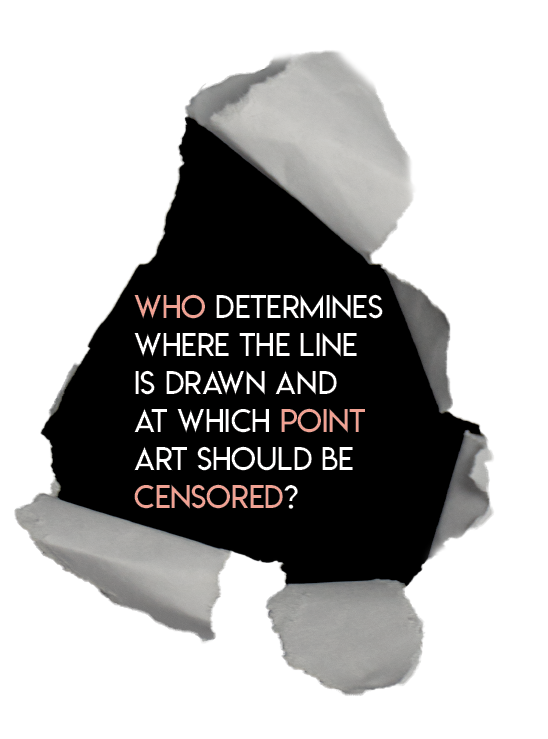
Bailey’s exhibit highlighted the objectification endured by the tribespeople and intended to demonstrate commanding snapshots of racism and colonialism. However, the exhibit was canceled from London’s performing arts Barbican Centre due to a large number of protests and serious threats that ensued after the rehearsal in Edinburgh. The opposition argued that the performance’s purpose was lost behind its depiction of undeniable racism: Black people put on display for white people’s enjoyment.
In response, Bailey defended his message, stating his intentions were to challenge perceptions and histories, not blatantly offend people.
The debate over whether a statement can become too offensive for public consumption is one that continues to plague the world; whether it be in a prestigious art exhibit or in a local display of student content. Our very own Artist of the Month, Rebecca Cheng, had her art removed without her knowledge, despite intending to highlight the injustices of her past.
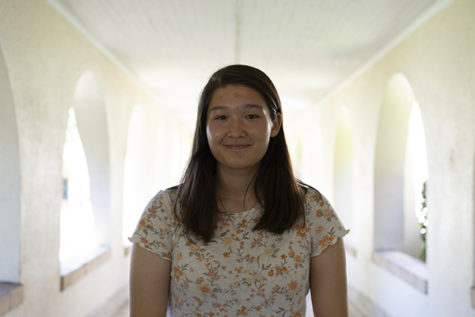
2018-2019 - Staff Writer
2019-2020 - Managing Editor
2020-2021 - Editor-in-Chief
Hear more about me!


